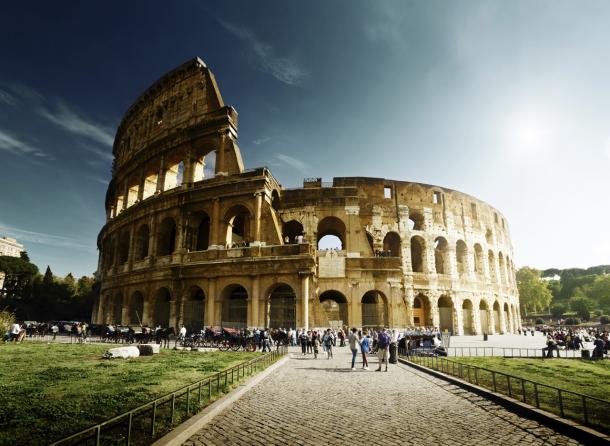Top 10 Tips When Visiting Rome
Here are ten tips that will make your stay easy when visiting the Eternal City. They are not in order of importance. They are meant to save time and improve your experience.
1. Never queue up at the Colosseum line. Rather, buy your ticket at the Palatine entrance, a hundred yards back, behind the Arch of Constantine. The lines here will always be shorter, even during busy holidays or Sunday mornings. The ticket is valid for 48 hours and allows entrance to the Palatine (so you can start visiting the great views immediately), the ancient Forum, and the Coliseum. Exit the Forum behind the Arch of Titus to reach the Coliseum. Remember, the Colosseum has a special line for ticket holders, so you can advance past the lines.

2. Avoid visiting the Vatican Museums in the morning. Even with a reservation and its surcharge, it will be a crowded experience, starting of course with the line and then the crowd inside the museum (except in January or February). An ideal time to start the visit without a reservation is in the early afternoon. The line will be shorter, faster, and the halls less crowded. You will have time to stroll through the most important rooms and get to the Sistine Chapel by 5pm (it closes at 6pm). Remember, not all “side” rooms are open at once.
3. In the Vatican Museums, do not miss the New Wing or “Braccio Nuovo”. It is off the traditional path leading to the Sistine Chapel, the aim of most visitors. After crossing the Pine-Cone Courtyard, take a right and walk the long room named the Chiaramonti Museum with dozens of sculptures. Turn right at the end into the gallery which holds the most important statues of the museum, including the Augustus of Prima Porta with its great historical details and the Nile sculptures. (Other rooms with great sculptures are often closed).
4. Wrap up your visit to the Vatican in style: try to exit the Sistine Chapel by the RIGHT door at the end of the room. It will take you directly into the cathedral where you may visit the crypt, climb the dome, or stroll in the immense space of Saint Peter’s basilica. Exiting through the left door will instead put you back into the very long museum circuit towards the exit. Be aware that for late afternoon visits, you should not expect the crypt and dome to be open.
5. Always eat your meals or get your pizza or sandwiches away from tourist hot spots such as Saint Peter, Fontana di Trevi, the Coliseum, and Piazza Navona where you are paying for the view more than the quality of food. The rule of thumb would be to move at least two blocks away from these spots, unless you have a recommendation that vouches for the restaurant in tourist spots.
6. Follow the recommendations of friends and trustworthy guides. This is most important when dining in restaurants where perhaps where your expectations are quite high and you have an opportunity to experience the local culture. We all want a good Italian meal in Rome. For example, while many Roman Carbonara pasta dishes are good, each restaurant has it own style regarding cooking time for the pasta, the crunchiness of the guanciale or pancetta (the bacon), the runniness of the egg, and the amount of Pecorino romano.
7. Get under the city! Rome is a marvellous city to see by foot in order to discover the monuments of different time periods side by side, but know that today’s city is built squarely on top of the large, bustling and dense metropolis that once ruled the ancient Mediterranean world. The best underground site in Rome is – back to the Vatican – under the church of Saint Peter. You will have to make a reservation well in advance. Also, without reservations the Church of Saint Clemente with its two underground levels is a must.
8. Visit the National Museum of Palazzo Massimo located in front of the Termini train station. It holds the best examples of Roman wall paintings, mosaics, and sculptures in marble and bronze in the city. It is the best deal in the city: for 10€ you are also entitled to visit (in a 3-day period) the Baths of Diocletian across the street, the Crypta Balbi which is part of the ancient theatre that houses the museum of the Middle Ages, and the Museo Altemps which holds statues that belonged to the Ludovisi collection, some of which were the property of Julius Caesar.
9. Visit the rich art held in Roman churches. They are free, but closed during lunch hours. This is the case for the paintings of Michelangelo Merisi, better known as Caravaggio. There are seven of his stunning paintings in three churches in Rome: San Luigi dei Francesi, Sant’Agostino, and Santa Maria del Popolo. There are also important murals to view by Pinturicchio at Santa Maria del Popolo and at Santa Maria in Aracoeli, and by Lippi at Santa Maria Sopra Minerva. Just do not mix up your Marias!
10. Do not expect great information in archaeological sites and museums. You will find detailed information in newer museums, but it is the exception rather than the rule. Such information is lacking in the center of it all at the Forum, the Palatine and the Coliseum, so bring a good guidebook or take a guided tour to really understand what you are seeing when in Rome.
Top destinations guides:
Rome (Roma): The Global Capital of Classical and Baroque Art
